
Chaenactis xantiana, the Mojave pincushion or Xantus pincushion, is a flowering plant in the family Asteraceae, native to the western United States, from southeastern Oregon, Nevada, southern and eastern California and northwestern Arizona. It is very common in the Antelope Valley in the Mojave Desert, and grows in sandy soils.

Monoptilon bellioides, the desert star, also called Mojave desertstar, is a desert flowering plant in the family Asteraceae.

Delphinium parishii, the desert larkspur, is a flowering plant in the family Ranunculaceae native to the Mojave Desert, in the southwestern United States and northwest Mexico. In Southern California it is also found in the Tehachapi Mountains, Transverse Ranges, and eastern Sierra Nevada.

Camissonia campestris, is a flowering plant in the family Onagraceae, native to the Mojave Desert of the United States. It grows mostly on open, sandy flats, occurring from sea level to 2,000 m in the western and central part of the desert.

Anisocoma acaulis is a wildflower found in the Mojave, Colorado Deserts, and California's Owens Valley above 2,000 feet (610 m), up to about 7000 ft.
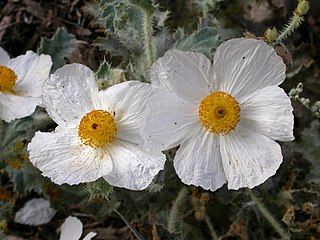
Argemone corymbosa, the Mojave prickly poppy, is a flowering plant in the family Papaveraceae native to the eastern Mojave Desert of the southwestern United States. It especially common around Cima, California and the nearby community of Kelso, California. The plant grows in sandy places and on dry slopes, and is very similar to desert prickly poppy.

Eremalche rotundifolia, the desert five-spot, is a flowering plant in the family Malvaceae, native to the Mojave Desert and Colorado Desert in the Southwestern United States.
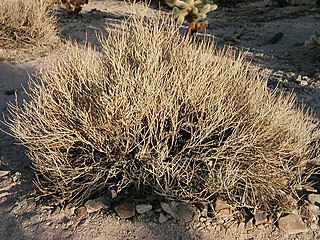
Senna covesii is a perennial subshrub in the family Fabaceae, native to the Mojave Desert and Sonoran Desert in southeastern California, southern Nevada, and Arizona in the United States, and northern Baja California in Mexico. It is found on desert plains and in sandy washes between 500 and 600 m above sea level, and is very common in Joshua Tree National Park. The specific epithet honors ornithologist Elliott Coues.
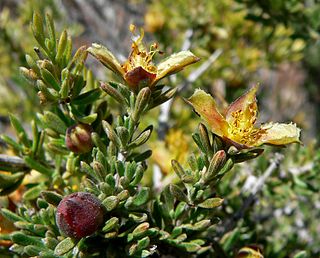
Coleogyne ramosissima or blackbrush, is a low lying, dark grayish-green, aromatic, spiny, perennial, soft wooded shrub, native to the deserts of the southwestern United States. It is called blackbrush because the gray branches darken when wet by rains. It is in the rose family (Rosaceae), and is the only species in the monotypic genus Coleogyne.

Dalea mollissima is a desert wildflower plant in the legume family (Fabaceae), with the common names soft prairie clover, downy dalea, and silk dalea.

The Kiavah Wilderness is a federally designated wilderness area located in the Mojave Desert, Scodie Mountains, and southern Sierra Nevada in Kern County, California, United States. California State Route 178 connects the town of Lake Isabella to State Highway 14 in the east, crossing Walker Pass at the north boundary of the wilderness.

The Sylvania Mountains Wilderness is a federally designated wilderness area located 30 miles (48 km) east of Bishop in the state of California. The wilderness is 18,677acres in size and is managed by the Bureau of Land Management (BLM). The California Desert Protection Act of 1994 created the Sylvania Mountains Wilderness and was added to the National Wilderness Preservation System. The wilderness is bordered by Nevada stateline on the east, Piper Mountain Wilderness on the west and Death Valley National Park to the south.

Rafinesquia neomexicana is a species of flowering plant in the family Asteraceae. Common names include desert chicory, plumeseed, or New Mexico plumeseed. It has white showy flowers, milky sap, and weak, zigzag stems, that may grow up through other shrubs for support. It is an annual plant found in dry climate areas of the southwestern deserts of the US and northwestern deserts of Mexico.
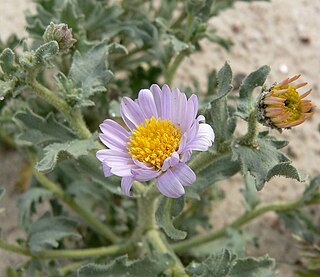
Arida arizonica,, is an annual plant in the, known by the common names arid tansyaster, desert tansyaster, and Silver Lake daisy. It is native to the very arid deserts of northern Mexico and the southwestern United States, and usually looks straggly and not very attractive. But in years with very heavy rainfall, it fills out and becomes rounded and bush like.
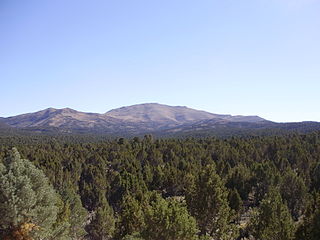
Pinyon–juniper woodland, also spelled piñon–juniper woodland, is a vegetation type (biome) of Western United States higher elevation deserts, characterized by being an open forest dominated by low, bushy, evergreen junipers, pinyon pines, and their associates which vary from region to region. The woodland's crown height may vary from less than 10 meters up to 15 meters, depending on the site. It may consist of pure stands of pinyon pine, or pure stands of juniper.
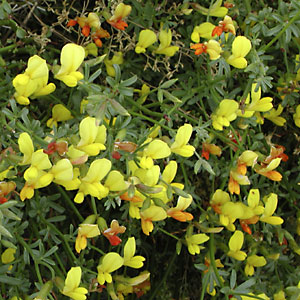
Ottleya rigida, synonyms Lotus rigidus and Acmispon rigidus, is a flowering plant in the pea family (Fabaceae), native to the southwestern United States and northwestern Mexico. It is known as shrubby deervetch or desert rock-pea. It is found in the Mojave Desert and Sonoran Desert.

Funastrum cynanchoides, fringed twinevine, twining milkweed or climbing milkweed, is a perennial plant in the family Apocynaceae that grows twining through other plants in the Mojave Desert and Sonoran Desert. It has milky sap and smells pungent. It is similar to Funastrum hirtellum.

Syntrichopappus fremontii, is a small annual plant in the Sunflower family (Asteraceae). It has yellow flower heads and grows in the Mojave Desert, to Utah and northwestern Arizona.

Hilaria rigida is a species of clumping perennial grass that is widespread in California deserts. It is commonly known as big galleta. It is a monocot in the Hilaria genus of the grass family (Poaceae).

Cuscuta denticulata, commonly known as desert dodder or small-toothed dodder, is a thin, yellow to orange, parasitic annual vine in the morning glory family (Convulvulaceae), native to the deserts of the south-western United States and northern Mexico.



















